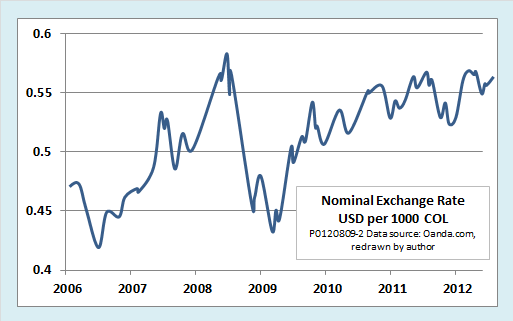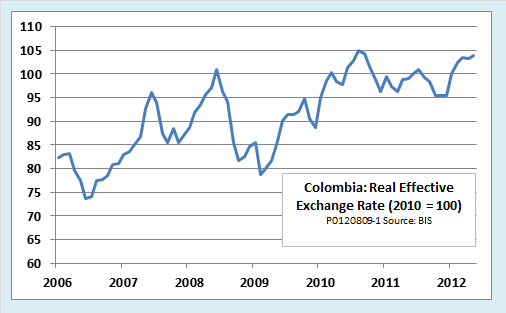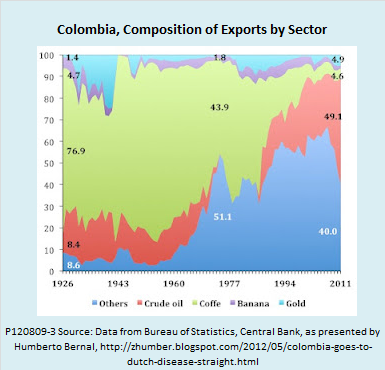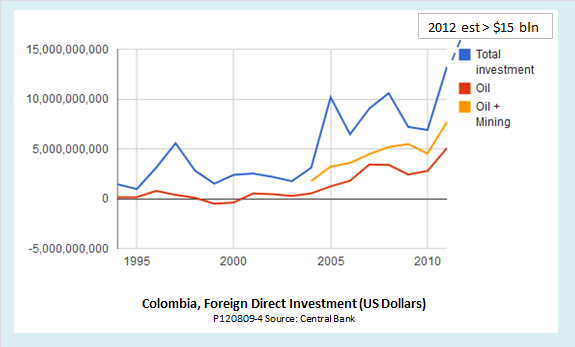After a torturous journey through Congress, the United States-Colombia Trade Promotion Agreement (CTPA), first signed in 2006, came into effect on May 15 of this year. The agreement has raised high hopes in Colombia, for which the United States is by far the largest trading partner. However, while the CTPA was fighting its way through a six-year obstacle course, a new threat to Colombia’s economy has emerged in the form of the dreaded Dutch Disease, which afflicts resource-rich countries in many parts of the world.
First, some positives. Although exporters of Colombian coffee, flowers, textiles, and other products had enjoyed some advantages under an earlier Andean preference system, the CTPA provides a more solid legal framework for long-term trade relationships. That has increased Colombia’s attractiveness as a partner for U.S. firms. For example, the garment trade news site Fashionista reports that companies including Gap and Victoria’s Secret are expressing interest in expanding manufacturing operations in Colombia. They cite the country’s geographic proximity and the willingness of its manufacturers to handle small orders as factors that could allow it to compete successfully with China, at least for some kinds of goods.
More generally, Colombia has won a reasonably good reputation as a business destination. The World Bank ranks it third among nations of the Caribbean and Latin America in ease of doing business, behind only Chile and Peru, and well ahead of Mexico. Transparency International ranks it 78th out of 178 countries surveyed on its Corruption Perceptions Index. That is behind Chile (21) and Brazil (69), but tied with China and well ahead of Mexico (98), two other favorite overseas sites for U.S. multinationals.
Now, the negatives. Over the six years since the CPTA was first signed, Colombia’s currency has appreciated steadily. The first chart below shows nominal appreciation of the peso relative to U.S. dollar. The second shows the peso’s real effective exchange rate. (The REER is a weighted average of exchange rates with all trading partners, corrected for differences in inflation.) Both measures show a steady loss of competitive position for Colombia’s manufacturing and agricultural exporters.

There is no secret about where the upward pressure on the peso is coming from. As the next chart shows, Colombia has rapidly become a major oil exporter. It is now the third-largest producer in Latin America, with output equal to a third of Mexico’s and two-fifths of Venezuela’s. Oil exports are giving Colombia a classic case of the Dutch disease. That affliction gets its name from the experience of The Netherlands, whose exchange rate rapidly appreciated when it first began producing natural gas from the North Sea. The appreciation, in turn, undermined the competitiveness of its traditional manufacturing and farm exports.
Resource-based export earnings are all well and good, but extractive industries, especially oil, employ relatively few people per dollar of value added. By making it hard for non-exractive sectors to compete, a rising exchange rate can block the spread of prosperity to the population at large. For example, the Fashionista report cited above estimates that Colombia’s textile manufacturers already must pay a minimum wage 70 percent higher than China’s. That puts the jobs of textile workers, farm workers, and others at risk as oil exports grow.
While some of the appreciation of Colombia’s exchange rate comes directly from oil exports, some also comes indirectly from strong inflows of foreign direct investment (FDI). As the next chart shows, FDI inflows have come out of nowhere to reach a projected $15 billion for 2012, nearly 60 percent of it directed to oil and mining. 
Is there anything resource-rich countries can do to resist the Dutch disease? Countries around the world have tried a variety of strategies, some with more success than others.
One essential measure to keep the extractive sector from strangling the rest of the economy is to maintain a good overall business environment. Canada and Australia are models in this regard. Both countries rank high on the World Bank’s Doing Business scale and Transparency International’s Corruption Perception Index. Russia and Nigeria, in contrast, rank near the bottom by both measures. Colombia is not Canada, but, as mentioned above, it is by and large a respectable place to do business and ranks among the best of its regional neighbors.
Exchange rate management is a second strategy for resisting the Dutch disease, but it is not as easy as it sounds. Simply declaring a fixed nominal exchange rate is not enough. To maintain a fixed exchange rate in the face of strong raw materials exports and FDI inflows, a central bank must purchase billions of dollars in foreign currency for its reserves. The domestic currency it uses to buy the added reserves floods into the domestic economy, causing inflation. A fixed nominal exchange rate plus rapid inflation create just as much real appreciation, and just as much loss of competitiveness, as does nominal appreciation of the currency without inflation.
Some countries try to get around the inflation problem by practicing so-called sterilized intervention. At the same time their central banks buy foreign exchange reserves, they neutralize the inflationary impact by selling other financial instruments, such as central bank bills. Alternatively, they may try to limit excess liquidity with high reserve requirements for commercial banks or other administrative measures. Unfortunately, sterilization does not always stabilize the real exchange rate as effectively as might be hoped. At the same time, it can have the unintended consequence of reducing the efficiency of the financial system. Colombia has experimented with sterilized intervention from time to time, but a recent IMF study finds those experiments to have had only limited success.
One final strategy against the Dutch disease is to establish a sovereign wealth fund into which a substantial share of export earnings are channeled. Placing resource royalties in a sovereign wealth fund does not have the same impact on inflation as does the accumulation of foreign exchange reserves by the central bank. Beyond mitigating inflation, a sovereign wealth fund has other benefits, too. In the short run, a sovereign wealth fund can be used to smooth business cycles and cycles of world commodity prices. Russia’s use of its sovereign wealth fund to fund budget shortfalls caused by the 2008 financial crisis is an example. Over a longer term, a sovereign wealth fund can help extend prosperity beyond the time when resource reserves are exhausted. Norway’s management of its North Sea oil wealth is a model in that regard.
In June 2011 the Colombian parliament approved the establishment of a sovereign wealth fund. Colombian investment analyst Caiman Valores describes its intended operation in these terms:
Of the [resource] royalties collected 30% are retained in a sovereign wealth fund held outside of Colombia, denominated in dollars. This was established as a means of reducing the impact of oil and gas earnings on the Colombian peso. From the remaining royalties only 25% are then distributed to local and regional governments in the departments where the oil and gas fields are operating, with the remainder being allocated to other budgetary requirements. These changes have been initiated as a means reducing corruption, increasing accountability and ensuring the greatest social and economic benefit from the royalties.
It is too early to judge the long-term effectiveness of the sovereign wealth fund, but the idea looks promising if properly implemented. Meanwhile, although growth of Colombia’s economy has slowed from almost 6 percent last year to a projected rate of 4.7 percent this year, the situation is not dire. Colombia’s non-resource exporters will have some uphill going if they are to take full advantage of their new opportunities under the CTPA, but with sound policies, the country should be able to avoid falling victim to the curse of riches.
Original post
- English (UK)
- English (India)
- English (Canada)
- English (Australia)
- English (South Africa)
- English (Philippines)
- English (Nigeria)
- Deutsch
- Español (España)
- Español (México)
- Français
- Italiano
- Nederlands
- Português (Portugal)
- Polski
- Português (Brasil)
- Русский
- Türkçe
- العربية
- Ελληνικά
- Svenska
- Suomi
- עברית
- 日本語
- 한국어
- 简体中文
- 繁體中文
- Bahasa Indonesia
- Bahasa Melayu
- ไทย
- Tiếng Việt
- हिंदी
Dutch Disease Kill Hopes Raised By Colombia’s Free Trade Agreement?
Published 08/10/2012, 02:38 AM
Updated 07/09/2023, 06:31 AM
Dutch Disease Kill Hopes Raised By Colombia’s Free Trade Agreement?
Latest comments
Loading next article…
Install Our App
Risk Disclosure: Trading in financial instruments and/or cryptocurrencies involves high risks including the risk of losing some, or all, of your investment amount, and may not be suitable for all investors. Prices of cryptocurrencies are extremely volatile and may be affected by external factors such as financial, regulatory or political events. Trading on margin increases the financial risks.
Before deciding to trade in financial instrument or cryptocurrencies you should be fully informed of the risks and costs associated with trading the financial markets, carefully consider your investment objectives, level of experience, and risk appetite, and seek professional advice where needed.
Fusion Media would like to remind you that the data contained in this website is not necessarily real-time nor accurate. The data and prices on the website are not necessarily provided by any market or exchange, but may be provided by market makers, and so prices may not be accurate and may differ from the actual price at any given market, meaning prices are indicative and not appropriate for trading purposes. Fusion Media and any provider of the data contained in this website will not accept liability for any loss or damage as a result of your trading, or your reliance on the information contained within this website.
It is prohibited to use, store, reproduce, display, modify, transmit or distribute the data contained in this website without the explicit prior written permission of Fusion Media and/or the data provider. All intellectual property rights are reserved by the providers and/or the exchange providing the data contained in this website.
Fusion Media may be compensated by the advertisers that appear on the website, based on your interaction with the advertisements or advertisers.
Before deciding to trade in financial instrument or cryptocurrencies you should be fully informed of the risks and costs associated with trading the financial markets, carefully consider your investment objectives, level of experience, and risk appetite, and seek professional advice where needed.
Fusion Media would like to remind you that the data contained in this website is not necessarily real-time nor accurate. The data and prices on the website are not necessarily provided by any market or exchange, but may be provided by market makers, and so prices may not be accurate and may differ from the actual price at any given market, meaning prices are indicative and not appropriate for trading purposes. Fusion Media and any provider of the data contained in this website will not accept liability for any loss or damage as a result of your trading, or your reliance on the information contained within this website.
It is prohibited to use, store, reproduce, display, modify, transmit or distribute the data contained in this website without the explicit prior written permission of Fusion Media and/or the data provider. All intellectual property rights are reserved by the providers and/or the exchange providing the data contained in this website.
Fusion Media may be compensated by the advertisers that appear on the website, based on your interaction with the advertisements or advertisers.
© 2007-2024 - Fusion Media Limited. All Rights Reserved.
